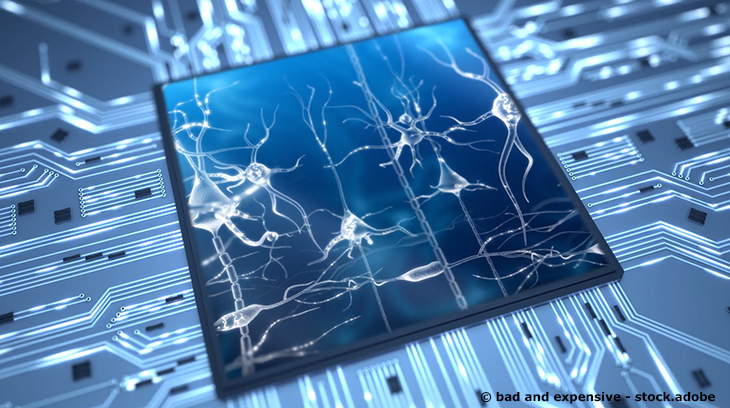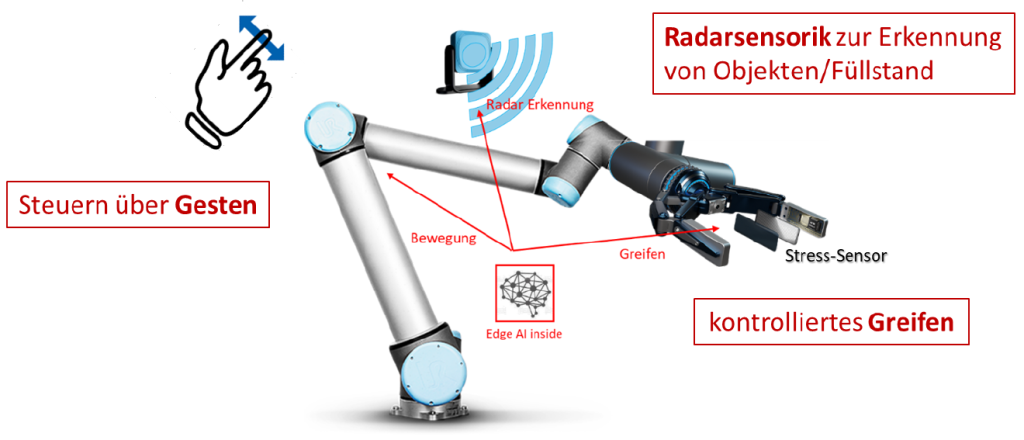DoRiE – AI for sensor-related applications in industrial use
Veröffentlicht am

Newsletter 2/2022
DoRiE - AI for sensor-related applications
Proprietary AI chip makes sensors “smart”

Nowadays, sensors are used in all areas of technical equipment. They constantly provide data on temperatures, pressure, current and voltage curves, etc., which must be reliably and continuously transmitted to central control units in order to determine operating conditions based on sensor data. Today, modern machines are equipped with a large number of sensors, which entail a corresponding amount of effort in terms of cabling and data transmission. A central control unit then provides a picture of the current operating status. A classic sensor only determines the measured value of a physical variable, but does not draw any conclusions from it. Using artificial intelligence (AI) methods, it is in principle possible to evaluate and classify sensor data. Ideally, this evaluation is carried out at the sensor and not in a control unit the sensor transmits the raw data to. An intelligent sensor can, on the one hand, check itself and, on the other hand, evaluate the data it measures. This way, instead of continuously transmitting temperature values, the AI sensor can transmit individually evaluated data: “Temperature is within the permissible range” and the amount of data to be transmitted can be drastically reduced, which greatly reduces the necessary bandwidth in communication and simplifies the evaluation, especially in applications with many sensors.
The research partners involved in the DoRiE project have laid the foundations for their own AI chips over the past two years in the successfully completed Baden- Württemberg-funded NeMoH project and are now implementing them in industrial reference applications.
An exciting application is the ongoing self-diagnosis of solenoid valves, in which the AI sensor simply observes the current curve of the valve during the switching process. Based on the typical course of the current curve, the condition of the valve can be determined with a high hit rate. This determines whether the valve is operating within normal boundaries, whether the medium is too hot, or whether the pressure of the medium is either too high or too low. Also, malfunctions, such as foreign bodies in the valve (grain of sand, incrustations) can be detected: “valve does not fully open” or “valve does not fully close”. Even the valve component temperature can be ascertained from the current curve. Equipped with the AI sensor, a component, such as a solenoid valve, can determine, its own operating status, and signal it to the outside.
In order to use this capability, numerous system data must be collected and classified in advance. To do this, extensive measurements with artificially induced fault conditions must be carried out on reference components in advance. In order to collect this data on the condition, the research partners have developed appropriate test rigs to automatically generate thousands of data sets. These data are used to train an artificial neuronal network. Which is then fed with actual measured values in the AI sensor application. The neural network now classifies the measured values into predefined condition categories.
For another demonstration of AI sensors, the research partners are currently developing a robotics application in which a robotic arm uses radar sensors (like those used to measure distance in distance cruise control systems) to orient itself in its environment and can be controlled by a human using hand gestures. The radar sensors generate very large amounts of data during operation, illustrating distances to and movements of objects. Again, neural networks are trained on different condition categories to be evaluated by an AI system close to the sensor in the application.

Robotic arm with sensor-based AI enables gesture control, object recognition
and grabbing objects by sensing them
The project is accompanied by an industry advisory board consisting of the Balluff, NEXT.robotics, Pilz, Schunk, Staiger and Swoboda companies, which helps define system requirements and monitors the implementation of the applications. In addition, the project offers a free opportunity for companies from Baden-Württemberg to check their own applications or ideas for possible AI sensor potential at any time. For this purpose, interested parties can apply for a QuickCheck for a feasibility study or an Exploring Project for a more in-depth investigation: ki.ims-chips.de